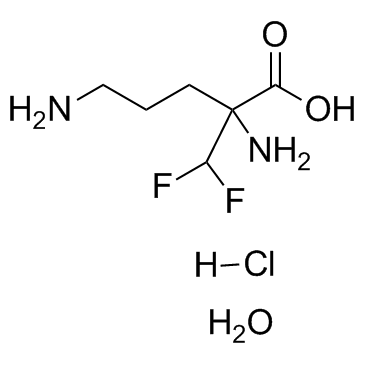Eflornithine (hydrochloride, hydrate)
Modify Date: 2024-01-03 16:51:52

Eflornithine (hydrochloride, hydrate) structure
|
Common Name | Eflornithine (hydrochloride, hydrate) | ||
|---|---|---|---|---|
| CAS Number | 96020-91-6 | Molecular Weight | 236.64500 | |
| Density | 1.293g/cm3 | Boiling Point | 347ºC at 760mmHg | |
| Molecular Formula | C6H15ClF2N2O3 | Melting Point | >210ºC (dec.) | |
| MSDS | N/A | Flash Point | 163.7ºC | |
Use of Eflornithine (hydrochloride, hydrate)Eflornithine hydrochloride, hydrate is a specific, irreversible inhibitor of the enzyme ornithine decarboxylase. Eflornithine is a medication for the treatment of African trypanosomiasis and excessive facial hair growth in women. |
| Name | DL-α-Difluoromethylornithine Hydrochloride Monohydrate |
|---|---|
| Synonym | More Synonyms |
| Description | Eflornithine hydrochloride, hydrate is a specific, irreversible inhibitor of the enzyme ornithine decarboxylase. Eflornithine is a medication for the treatment of African trypanosomiasis and excessive facial hair growth in women. |
|---|---|
| Related Catalog | |
| In Vivo | Eflornithine is the only new molecule registered for the treatment of human African trypanosomiasis over the last 50 years. It is the drug used mainly as a back-up for melarsoprol refractory Trypanosoma brucei gambiense cases[1]. In subjects with excessive, unwanted facial hair, eflornithine 15% cream is superior to placebo in reducing hair growth. After 24 weeks' treatment, 58% of eflornithine and 34% of placebo subjects have at least some improvement in facial hirsutism[2]. The hair growth inhibitory activity of eflornithine is significantly enhanced when the eflornithine cream is applied onto a mouse skin area pretreated with microneedles[3]. Treatment of coarctation hypertensive rats with eflornithine results in a normalization of the contractile intensity to KCI and norepinephrine and relaxations to acetylcholine by 14 days of hypertension[4]. |
| Animal Admin | Mice: The skin area where the hair is removed is then treated with the eflornithine hydrochloride 13.9% cream (-50 mg per mouse per treatment) using a spatula 2 times a day in an interval of at least 8 h for a maximum period of 36 days[3]. |
| References |
[2]. Balfour JA, et al. Topical eflornithine. Am J Clin Dermatol. 2001;2(3):197-201; discussion 202. |
| Density | 1.293g/cm3 |
|---|---|
| Boiling Point | 347ºC at 760mmHg |
| Melting Point | >210ºC (dec.) |
| Molecular Formula | C6H15ClF2N2O3 |
| Molecular Weight | 236.64500 |
| Flash Point | 163.7ºC |
| Exact Mass | 236.07400 |
| PSA | 98.57000 |
| LogP | 1.91080 |
| Storage condition | 2~8°C |
| HS Code | 2922499990 |
|---|
| HS Code | 2922499990 |
|---|---|
| Summary | HS:2922499990 other amino-acids, other than those containing more than one kind of oxygen function, and their esters; salts thereof VAT:17.0% Tax rebate rate:9.0% Supervision conditions:AB(certificate of inspection for goods inward,certificate of inspection for goods outward) MFN tariff:6.5% General tariff:30.0% |
| 2,5-diamino-2-(difluoromethyl)pentanoic acid,hydrate,hydrochloride |
| Eflornithine (hydrochloride, hydrate) |

